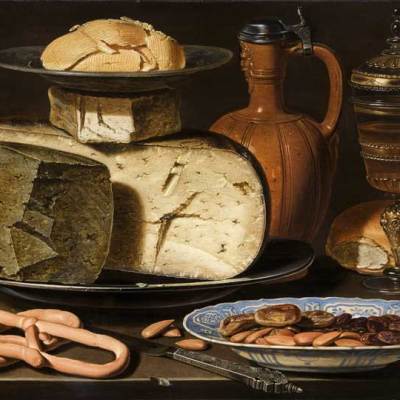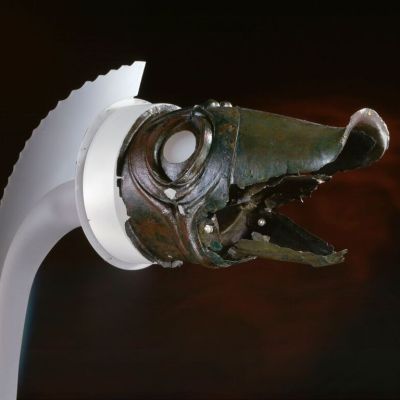From the February issue of Apollo: preview and subscribe here
In the summer of 1838, the artist Edward Henry Corbould arrived at Goodrich Court near Ross-on-Wye in Herefordshire, one of the earliest and most romantic examples of neo-gothic architecture (built 1828–31). It was the home of Sir Samuel Rush Meyrick, father of the modern scholarly study of medieval and Renaissance arms and armour, and one of the world’s foremost collectors of ancient weapons. A significant portion of Meyrick’s collection was later acquired by Sir Richard Wallace, and is now in my care at the Wallace Collection.
Corbould, a painter specialising in romantic historical subjects, had come to Goodrich to study Meyrick’s collection, which at that time was as large and comprehensive as it would get. A cavalcade of equestrian figures lined both sides of the great hall, while most rooms in the house contained groups of glittering armours for war, tournament, and parade, along with hundreds of swords, lances, and all the paraphernalia of chivalry. The artist was no doubt impressed.
‘Meyrick was the greatest of the giants on whose shoulders we stand’
A prominent topic of conversation over dinner must have been the recent announcement that Archibald, 13th Earl of Eglinton (1812–61), would be hosting a huge medieval tournament in Scotland. Both men knew Lord Eglinton; both were involved in his grand plan. One important source of inspiration for Eglinton’s bold idea was Meyrick’s historic work A Critical Enquiry into Antient Armour (1824). This book had solidified the author’s reputation as the great authority on the subject. It had also kickstarted a popular interest in the age of chivalry, a movement which was accelerated by the Eglinton Tournament of 28–29 August 1839.
Today the 13th Earl’s personal copy of Antient Armour resides in the Wallace Collection archive. I often wonder how different Victorian cultural history might have been had the Earl never acquired it, or if Meyrick had never written it. Lord Eglinton, like Meyrick, was a lover of ceremony, and his determination to hold a lavish chivalric spectacle was said to have been motivated by his outrage at the reduction of traditional lavishness at Queen Victoria’s ‘penny’ coronation. Today, the Eglinton Tournament is remembered as the spectacular opening charge into full-blown 19th-century medieval revival. At the time however, it was a humiliating anti-climax because of heavy rain, high winds, and the ineptitude of most of the participants. Corbould, as Eglinton’s official artist, thus became a sort of visual ‘spin doctor’; he not only produced a series of prints depicting idealised highlights of the event (leaving out the wet and embarrassing parts), but also painted the glorious equestrian portrait of Lord Eglinton in his gilded armour, now in the Victoria and Albert Museum.
Lord Eglinton dressed as the Lord of the Tournament (c. 1840), Edward Henry Corbould (1815–1905), oil on panel, 53.3 × 42.5cm. Victoria and Albert Museum, London

I wonder what Meyrick made of the Eglinton Tournament. The Earl seems to have had no real interest in the past. Much more important were his notions of what history should have been, or what he wished it had been. He strove above all to bring an arch-conservative fantasy to life in an age of Whig reform. Meyrick, on the other hand, had a genuine desire to understand the past. He had collected armour since the early 1800s. As a legal advocate, he had the required income, and he was buying at a time when art prices had crashed in the wake of the Napoleonic Wars. By 1820, his collection was renowned as a rich source of study objects for artists.
Two of his artist-guests were Eugène Delacroix and Richard Parkes Bonington, who spent several days in 1825 at Meyrick’s house in London, drawing his collection. A number of these drawings survive, in the Wallace Collection archive and elsewhere. Delacroix was especially intrigued by the armour of Thomas Sackville, Baron Buckhurst (1536–1608), made in the Greenwich royal workshop in c. 1587, a superb demonstration of Renaissance English armour-making now in the Wallace Collection.
Meyrick died in 1848. In 1869 his heir decided to sell Goodrich Court, and the collection was exhibited at the South Kensington Museum (now the V&A). First offered for sale to the government, which declined, the collection was dispersed. Many of the best pieces were bought by Frédéric Spitzer, a Parisian dealer, who sold them to Sir Richard Wallace.
Meyrick defined how subsequent generations looked at this subject, through his writing and through the work of the artists and medieval revivalists who visited and were inspired by his collection. For students of arms and armour, Meyrick was the first and greatest of those giants on whose shoulders we stand.
Tobias Capwell is the Curator of Arms and Armour at the Wallace Collection. His books include Armour of the English Knight 1400–1450 (Thomas Del Mar).


